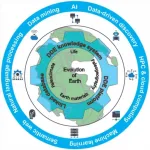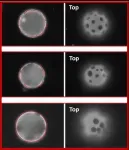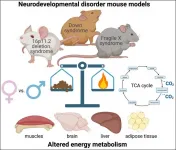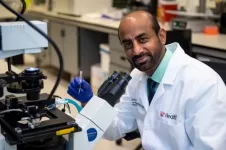(Press-News.org) Humans have long explored three big scientific questions: evolution of the universe, evolution of Earth, and evolution of life. Geoscientists have embraced the mission of elucidating the evolution of Earth and life, which are preserved in the information-rich but incomplete geological record that spans more than 4.5 billion years of Earth history. Delving into Earth's deep-time history helps geoscientists decipher mechanisms and rates of Earth's evolution, unravel the rates and mechanisms of climate change, locate natural resources, and envision the future of Earth.
Two common approaches, deductive reasoning and inductive reasoning, have been widely employed for studying Earth's history. In contrast to deduction and induction, abduction is derived from accumulation and analysis of large amounts of reliable data, independently of a premise or generalization. Abduction thus has the potential to generate transformative discoveries in science. With the accumulation of enormous volumes of deep-time Earth data, we are poised to transform research in deep-time Earth Science through data-driven abductive discovery.
However, three issues must be resolved to facilitate abductive discovery utilizing deep-time databases. First, many relevant geodata resources are not in compliance with FAIR (findable, accessible, interoperable, and reusable) principles for scientific data management and stewardship. Second, concepts and terminologies used in databases are not well defined, thus the same terms may have different meanings across databases. Without standardized terminology and definitions of concepts, it is difficult to achieve data interoperability and reusability. Third, databases are highly heterogeneous in terms of geographic regions, spatial and temporal resolution, coverages of geological themes, limitations of data availability, formats, languages, and metadata. Due to the complex evolution of Earth and interactions among multiple spheres (e.g., lithosphere, hydrosphere, biosphere, and atmosphere) in Earth systems, it is difficult to see the whole picture of Earth's evolution from separated thematic views, each with limited scope.
Big data and artificial intelligence are creating opportunities for resolving these issues. To explore Earth's evolution efficiently and effectively through deep-time big data, we need FAIR, synthetic, and comprehensive databases across all fields of deep-time Earth science, couple with tailored computation methods. This goal motivates the Deep-time Digital Earth program (DDE), which is the first "big science program" initiated by the International Union of Geological Sciences (IUGS) and developed in cooperation with national geological surveys, professional associations, academic institutions, and scientists around the world. The main objective of DDE is to facilitate deep-time, data-driven discoveries through international and interdisciplinary collaborations. DDE aims to provide an open platform for linking existing deep-time Earth data and integrating geological data that users can interrogate by specifying time, space, and subject (i.e., a "Geological Google") and for processing data for knowledge discovery using a knowledge engine (Deep-time Earth Engine) that provides computing power, models, methods, and algorithms (Figure 1).
To achieve its mission and vision, the DDE program has three main components: program management committees, centers of excellence, and working, platform and task groups. And DDE will build on existing deep-time Earth knowledge systems and develop an open platform (Figure 2). A deep-time Earth knowledge system consists of the basic definitions and relationships among concepts in deep-time Earth, which are necessary for harmonizing deep-time Earth data and developing a knowledge engine for supporting abductive exploration of Earth's evolution. The first step in DDE's research plan is to build on existing deep-time Earth knowledge systems. The second step in DDE's research plan is to build an interoperable deep-time Earth data infrastructure. And the third step in DDE's research plan is to develop a deep-time Earth open platform.
The execution of the DDE program consists of four phases. In Phase 1, DDE establishes an organizational structure with international standards of policy and management. In Phase 2, DDE forms the initial teams and builds on existing deep-time Earth knowledge systems and data standards by collaborating with existing ontology researchers in the geosciences, while working to link and harmonize deep-time Earth databases. In Phase 3, DDE develops tailored algorithms and techniques for environments of cloud computing and supercomputing. In Phase 4, Earth scientists and data scientists collaborate seamlessly on compelling and integrative scientific problems.
As integrative and international ambitions of the DDE program, several challenges were anticipated. However, by creating an open-access data resource that for the first time integrates all aspects of Earth's narrated past, DDE holds the promise of understanding our planet's past, present, and future in new and vivid detail.
INFORMATION:
See the article:
The Deep-time Digital Earth program: data-driven discovery in geosciences. Wang et al., National Science Review,
https://doi.org/10.1093/nsr/nwab027
Researchers from North Carolina State University have developed an exosome-coated stent with a "smart-release" trigger that could both prevent reopened blood vessels from narrowing and deliver regenerative stem cell-derived therapy to blood-starved, or ischemic, tissue.
Angioplasty - a procedure that opens blocked arteries - often involves placing a metal stent to reinforce arterial walls and prevent them from collapsing once the blockage is removed. However, the stent's placement usually causes some injury to the blood vessel wall, which stimulates smooth muscle cells to proliferate and migrate to the site in an attempt to repair the injury. The result is restenosis: a re-narrowing of the blood vessel previously opened by angioplasty.
"The ...
ITHACA, N.Y. - The cost of harvesting solar energy has dropped so much in recent years that it's giving traditional energy sources a run for their money. However, the challenges of energy storage - which require the capacity to bank an intermittent and seasonally variable supply of solar energy - have kept the technology from being economically competitive.
Cornell University researchers led by Lynden Archer, Dean and Professor of Engineering, have been exploring the use of low-cost materials to create rechargeable batteries that will make energy storage more ...
AMHERST, Mass. - A team of polymer science and engineering researchers at the University of Massachusetts Amherst has demonstrated for the first time that the positions of tiny, flat, solid objects integrated in nanometrically thin membranes - resembling those of biological cells - can be controlled by mechanically varying the elastic forces in the membrane itself. This research milestone is a significant step toward the goal of creating ultrathin flexible materials that self-organize and respond immediately to mechanical force.
The team has discovered that rigid solid plates in biomimetic fluid membranes experience interactions ...
Mouse models of neurodevelopmental disorders possess unique, sex-specific metabolic dysfunctions, according to a new study in eNeuro. Understanding the unique metabolic effects of each disorder in both animal models and humans may lead to more personalized treatments and diagnostic methods.
Any disorder affecting the brain also impacts the body. People with neurodevelopmental disorders -- including Down syndrome and autism spectrum disorders -- are at increased risk for developing diabetes, obesity, and hypertension. Yet the impact of these three disorders on metabolism has not been studied.
Menzies et al. measured the resting energy metabolism of three neurodevelopmental disorder mouse models: Down syndrome, ...
A new report by AARP Pennsylvania and Drexel University's College of Nursing and Health Professions highlights how geographic, racial/ethnic and economic factors are combining to restrict access to health care services for many Pennsylvanians, creating disparities that have become more pronounced during the COVID-19 pandemic.
"Disrupting Disparities in Pennsylvania: Retooling for Geographic, Racial and Ethnic Growth" shows that health inequities are most acute among those living in rural and low resourced areas of the state, and among underrepresented populations (particularly Black/African American and Latino), who lack access to health care, experience digital divide and face persistent ...
In an effort to save her beloved animals, Kathy Janson, a Maine Coon cat enthusiast reached out to a University of Cincinnati researcher to find a way to help her pets who were developing heart troubles.
Maine Coon cats are known as great mousers, popular farm cats and, of course, for their enormous size. The New England breed is a really big cat and can weigh up to 19 pounds and grow up to 40 inches in length. Janson fell in love with these animals more than 25 years ago bringing them into her Cincinnati suburban home to become part of her family.
"Maine ...
Researchers from the University of Minnesota Twin Cities College of Science and Engineering and Medical School have developed a unique head-mounted mini-microscope device that allows them to image complex brain functions of freely moving mice in real time over a period of more than 300 days.
The device, known as the mini-MScope, offers an important new tool for studying how neural activity from multiple regions of the outer part of the brain, called the cortex, contribute to behavior, cognition and perception. The groundbreaking study provides new insight into fundamental research that could improve human brain conditions such as concussions, autism, Alzheimer's, and Parkinson's disease, as well as better understanding ...
A study at the University of Chicago Medicine found U.S. women experienced increased incidence of health-related socioeconomic risks (HRSRs), such as food insecurity and interpersonal violence, early in the COVID-19 pandemic. This was associated with "alarmingly high rates" of mental health problems, including depression and anxiety. The research was published April 5 in the Journal of Women's Health.
Other studies have found evidence for higher rates of anxiety and depression and related issues, such as alcohol overuse, connected to the pandemic -- but this study is the first to link early pandemic-related changes in HRSRs to mental health effects ...
Researchers at the National Institute of Standards and Technology (NIST) and collaborators have demonstrated an atom-based sensor that can determine the direction of an incoming radio signal, another key part for a potential atomic communications system that could be smaller and work better in noisy environments than conventional technology.
NIST researchers previously demonstrated that the same atom-based sensors can receive commonly used communications signals. The capability to measure a signal's "angle of arrival" helps ensure the accuracy of radar and wireless communications, ...
RIVERSIDE, Calif. -- A team led by a biomedical scientist at the University of California, Riverside, has developed a new RNA-sequencing method-- "Panoramic RNA Display by Overcoming RNA Modification Aborted Sequencing," or PANDORA-seq -- that can help discover numerous modified small RNAs that were previously undetectable.
RNA plays a central role in decoding the genetic information in DNA to sustain an organism's life. It is generally known as the intermediate molecule used to synthesize proteins from DNA. Cells are full of RNA molecules in complex and diverse forms, two main types ...





